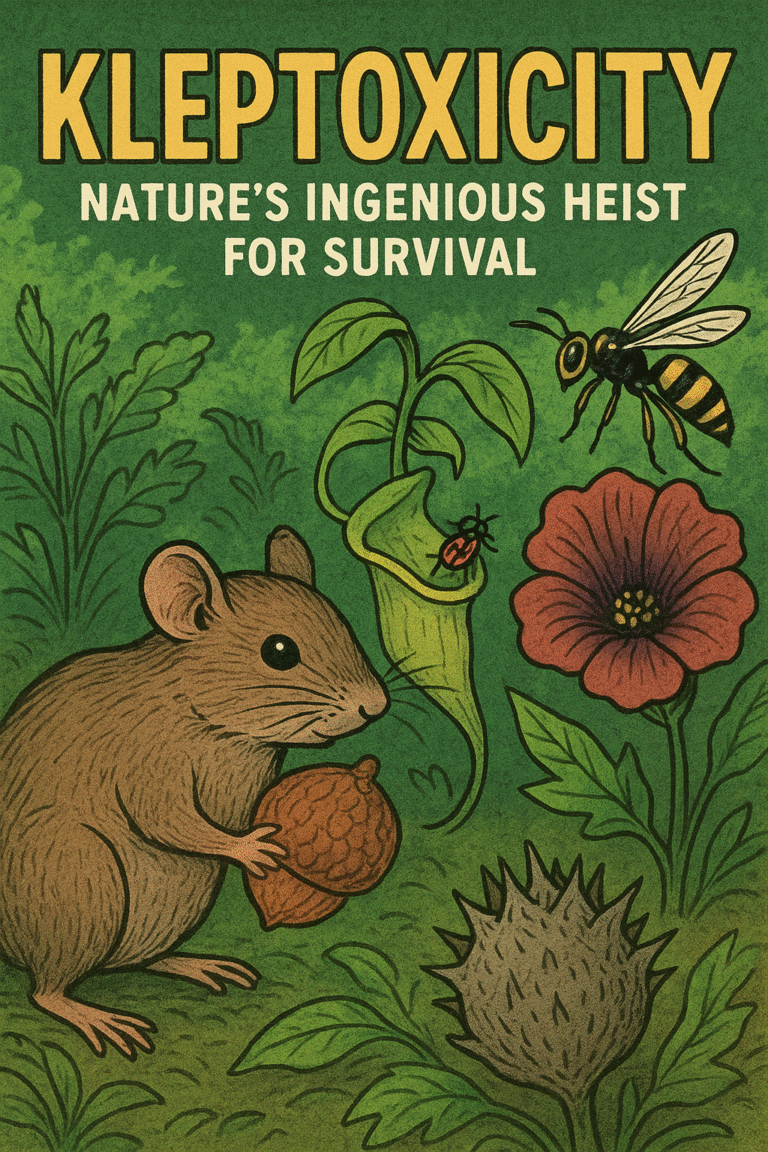Introduction
Ever wondered how some creatures manage to ward off predators without producing their own venom? Welcome to the world of kleptotoxicity—a clever survival hack where animals “borrow” toxins from their diet to use as chemical armor. It’s like nature’s version of a heist, but instead of jewels, they’re stealing poisons!
In this article, we’ll dive into the science behind kleptotoxicity, explore real-world examples, and understand its significance in the grand tapestry of life.
What Is Kleptotoxicity?
Kleptotoxicity is a biological strategy where organisms acquire toxins from other species and use them for their own defense. The term combines “klepto,” meaning theft, and “toxicity,” referring to poison. Instead of producing their own toxic compounds, these organisms “steal” them by consuming toxic prey or plants and store them for later use.
This strategy allows species to deter predators without expending energy on toxin production. It’s a brilliant example of nature’s resourcefulness!
How Does Kleptotoxicity Work?
The process of kleptotoxicity involves several steps:
-
Acquisition: The organism consumes a toxic prey or plant.
-
Storage: The toxins are stored in specialized tissues or organs.
-
Utilization: When threatened, the organism uses these stored toxins for defense.
For example, certain sea slugs ingest toxic sponges and store the toxins in their tissues. When predators attempt to eat them, they encounter the stored toxins, deterring the attack.
Real-World Examples of Kleptotoxicity
Sea Slugs (Nudibranchs)
Nudibranchs are colorful sea slugs known for their ability to sequester toxins from their prey, such as toxic sponges. They store these toxins in specialized cells, making them distasteful or even harmful to potential predators.
Poison Dart Frogs
These frogs obtain their potent toxins from their diet, primarily ants and other small arthropods. The toxins are stored in their skin, serving as a deterrent to predators.
Milkweed Butterflies
Milkweed butterflies feed on milkweed plants, which contain toxic compounds. The butterflies store these toxins in their bodies, making them unpalatable to predators.
Why Is Kleptotoxicity Important?
Kleptotoxicity plays a crucial role in ecosystems by:
-
Enhancing Survival: Provides organisms with a defense mechanism without the need for energy-intensive toxin production.
-
Influencing Food Webs: Affects predator-prey interactions and can alter the dynamics of food webs.
-
Driving Evolution: Encourages coevolution between predators and prey, leading to the development of new strategies and adaptations.
The Science Behind Kleptotoxicity
Researchers study kleptotoxicity using various methods:
-
Chemical Analysis: Identifying and quantifying toxins in organisms.
-
Stable Isotope Tracing: Tracking the origin of toxins to confirm their acquisition from the diet.
-
Genomic Studies: Determining whether the organism produces its own toxins or sequesters them.
These studies help scientists understand the mechanisms of kleptotoxicity and its ecological implications.
FAQs About Kleptotoxicity
Q1: Is kleptotoxicity the same as mimicry?
No, mimicry involves imitating the appearance of another organism, while kleptotoxicity involves acquiring and using toxins from other species.
Q2: Can humans benefit from studying kleptotoxicity?
Absolutely! Understanding how organisms utilize toxins can lead to the discovery of new pharmaceuticals and pest control methods.
Q3: Are there any risks associated with kleptotoxicity?
While kleptotoxicity provides defense mechanisms, it can also make organisms more susceptible to environmental changes that affect their toxic prey or plants.
Conclusion
Kleptotoxicity is a testament to nature’s ingenuity, showcasing how organisms can adapt and thrive by “borrowing” from others. This strategy not only enhances survival but also shapes the intricate web of life in ecosystems. As we continue to explore and understand these remarkable adaptations, we gain deeper insights into the complexities of life on Earth.

